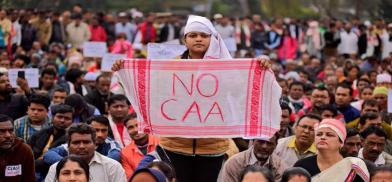Anti-CAA protests in India mask Assam’s lonely struggle
The nature of protests and participation of people in anti-CAA rallies in Assam indicates that Assam rejects the communal agenda of the current BJP-led government and diversionary tactics of the mainstream media, write Minakshi Bujarbaruah & Rituparna Kaushik Bhattacharya for South Asia Monitor

It is over a month now that the Citizenship Amendment Bill was enacted by Parliament and became law. On the night of January 10, 2020, India's home ministry issued a notification that the Citizenship Amendment Act (CAA) would be enforced with immediate effect. For the past one month, the streets of Assam have echoed to the immortal tunes of Bhupen Hazarika’s songs, a reminder and a reawakening of the six-year-long struggle of the Assam Agitation, between 1979-1985. The concern remains the same; only this time around the entire nation has woken up to voice its angst. This time the issue extends beyond Assam and, for the larger nation, it is a matter of exclusionary politics of the ruling party by transgressing secular ideals of the Indian Constitution.
An important question arises at this juncture. Let us assume that persecuted people, irrespective of religion, from neighbouring nations, are granted citizenship by India. Such a move would be hailed and celebrated by the entire nation. However, nothing much would change for people in Assam and Tripura (the remaining states in the region and minuscule parts of Assam and Tripura are protected under the 6th Schedule of the Constitution and the Inner Line Permit). The narrative of the northeastern frontier, especially Assam and Tripura, remains very different. Vocal protests there started much before the mainland’s agony. However, this drew little national attention.
To understand this anti-CAA stance in the Northeast, primarily in Assam and Tripura, it is necessary to look at the history of oppression faced by the people of the region. Assam is a multi-ethnic and multi-lingual state, as diverse as India itself. The rich demographic composition of the state, that includes multiple indigenous groups and identities, make issues in the region complex and layered. Crucially, there are also a large number of Bengal-origin Hindus and Muslims with roots in East Bengal, now Bangladesh. Protests in Assam have been interesting as people from these communities, in huge numbers, have also expressed solidarity.
Assam has had a long, tumultuous relationship with East Bengal - earlier Pakistan and then Bangladesh. Assam’s struggle with illegal migration is not new. It started soon after Assam fell into the hands of the British colonial administration, with the signing of the Treaty of Yandaboo in 1826. Assam was placed under the Bengal administration and, in 1836, Bengali replaced Assamese as the language of administration and medium of instruction. Imposition of Bengali as the medium of instruction and language of administration led to frustration among the intelligentsia and the common people. This led to the slow progress of education in Assam and the cultural life and identity of the indigenous people underwent a slow degeneration.
Opposition to this imposition gained momentum when the colonial administration settled Bengalis from East Bengal in fertile agricultural lands and in administrative positions in Assam. The colonial administration encouraged the migration of Muslim Bengalis from East Bengal to unused fertile lands to cultivate rice and cash crops like jute. Abundant fertile land also naturally attracted many Muslim Bengali peasants to work on. Administrative positions in the state were filled with Bengali Hindus. A sudden rise in their numbers in government jobs and continuous deprivation of the indigenous population led to frustration amongst the Axomiya population.
Unchecked migration from East Bengal started to put pressure on the once resource-abundant state and conflict started to simmer. The pressure on the state and the fight for resources became stronger with migration occurring between the partition years of 1947 and Bangladesh Liberation War period ending in 1971. Migration not only created a demographic imbalance, but also a struggle for land and resource ownership which continued to brew for decades, even denying the promise and provisions of the Assam Accord of 1985.
The concern raised by those protesting against the CAA reiterate and scratch old wounds where the threat to the language, culture, political rights and the overall way of life of the Axomiya masses remain the focal apprehension. Repeated betrayal by the ‘mainland’ and local political class has also left a deep scar. The CAA now enacted opens another can of worms of the past decades and may jeopardize the slow peace and reconciliation process achieved in the last decade.
The nature of protests and participation of people in anti-CAA rallies in Assam indicates that Assam rejects the communal agenda of the current BJP-led government and diversionary tactics of the mainstream media. In these protests, the power of music and visual art as a symbol of resistance and political expression has been well exemplified by the people of Assam. It is perhaps due to this nature of the struggle, where the angst of the commoners move beyond divisive Hindu-Muslim politics, that Assam or the Northeast as a whole is unable to garner the attention and empathy of mainland politicians, media and the intelligentsia.
Added to this, there is yet another section that has conveniently been calling Assam xenophobic, by simply ignoring the region’s history, its continuous struggle, and complete silencing of the discourse within mainstream politics.
But having said that, people of Assam also need to realize and introspect over tragic historical events like the Nellie massacre, the ‘Bihari Bhagao’ movement and controversy surrounding Miya poetry. Such episodes within the state need to find space rather than being completely muted. Even at this crucial juncture, while struggling for the survival of Assam’s culture, language and indigenous people, these innate problems must be addressed.
In the backdrop of this tangled history of identity and politics of assertion and negotiation, the larger coverage of the anti-CAA stand in the country has failed to cover the muddled layers of Assam’s lonely struggle. What has now become just a matter of communal politics, of secularism and reducing it merely to an anti-Muslim Act, is far from the reality of issues and concerns raised by the Assamese people for their land, culture and identity.
(The writers are researchers in Guwahati and Delhi)




















Post a Comment